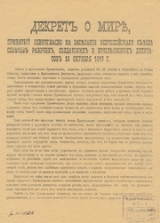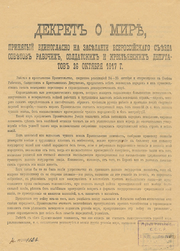
Decree on Peace
Encyclopedia

Vladimir Lenin
Vladimir Ilyich Lenin was a Russian Marxist revolutionary and communist politician who led the October Revolution of 1917. As leader of the Bolsheviks, he headed the Soviet state during its initial years , as it fought to establish control of Russia in the Russian Civil War and worked to create a...
, was passed by the Second Congress of the Soviet
Soviet (council)
Soviet was a name used for several Russian political organizations. Examples include the Czar's Council of Ministers, which was called the “Soviet of Ministers”; a workers' local council in late Imperial Russia; and the Supreme Soviet of the Soviet Union....
of Workers', Soldiers', and Peasants' Deputies on the 26 October 1917, following the success of the October Revolution
October Revolution
The October Revolution , also known as the Great October Socialist Revolution , Red October, the October Uprising or the Bolshevik Revolution, was a political revolution and a part of the Russian Revolution of 1917...
. It was published in the Izvestiya newspaper, #208, October 27, 1917. It proposed an immediate withdrawal of Russia from World War I
World War I
World War I , which was predominantly called the World War or the Great War from its occurrence until 1939, and the First World War or World War I thereafter, was a major war centred in Europe that began on 28 July 1914 and lasted until 11 November 1918...
.
Extracts
The workers' and peasants' government, created by the Revolution of October 24-25 and basing itself on the Soviet of Workers', Soldiers' and Peasants' Deputies, calls upon all the belligerent peoples and their government to start immediate negotiations for a just, democratic peace.By a just or democratic peace, for which the overwhelming majority of the working class and other working people of all the belligerent countries, exhausted, tormented and racked by the war, are craving — a peace that has been most definitely and insistently demanded by the Russian workers and peasants ever since the overthrow of the tsarist monarchy — by such a peace the government means an immediate peace without annexations (i.e., without the seizure of foreign lands, without the forcible incorporation of foreign nations) and without indemnities.
[...]
The government proposes an immediate armistice to the governments and people of all the belligerent countries, and, for its part, considers it desirable that this armistice should be concluded for a period of not less than three months, i.e., a period long enough to permit the competition of negotiations for peace with the participation of the representatives of all peoples or nations, without exception, involved in or compelled to take part in the war, and the summoning of authoritative assemblies of the representatives of the peoples of all countries for the final ratification of the peace terms.
[...]
The governments and the bourgeoisie will make every effort to unite their forces and drown the workers' and peasants' revolution in blood. But the three years of war have been a good lesson to the masses — the Soviet movement in other countries and the mutiny in the German navy, which was crushed by the officer cadets of Wilhelm the hangman. Finally, we must remember that we are not living in the depths of Africa, but in Europe, where news can spread quickly.
The workers' movement will triumph and will pave the way to peace and socialism. (Prolonged Applause)

